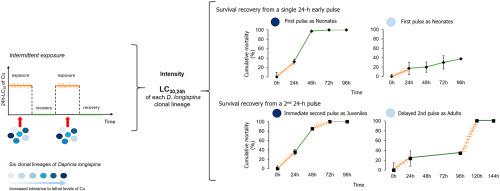Chemosphere ( IF 8.1 ) Pub Date : 2020-09-24 , DOI: 10.1016/j.chemosphere.2020.128403 C. Venâncio , R. Ribeiro , A.M.V.M. Soares , I. Lopes

|
Natural populations are commonly exposed to sequential pulses of contaminants. Accordingly, this study aimed at testing the existence of an association between the tolerance to lethal levels of copper (Cu) and the survival recovery ability from pulsed partially lethal copper exposures in six clonal lineages of Daphnia longispina. It was hypothesized that the most tolerant genotypes would be the ones exhibiting a faster survival recovery from a pulsed contaminant exposure. For each clonal lineage, the intensity of pulses corresponded to the respective concentration of Cu causing 30% of mortality after 24h of exposure (LC30,24h). The initial hypothesis was not corroborated: obtained results showed no association between survival recovery and lethal tolerance to Cu. Nevertheless, some patterns could be detected. Firstly, the most sensitive lineages to lethal levels of copper revealed a faster survival recovery from a first Cu pulse comparatively to the most tolerant ones, though they were the most sensitive to a second pulse exposure. Secondly, the most tolerant lineages, though being more tolerant to a second exposure, exhibited the lowest survival recovery capacity after exposure to a first pulse of Cu. However, differences in the survival recovery capacity of the six clonal lineages after the exposure to the two pulses of Cu were not observed. Increasing the duration of the recovery period from 24h to 72h did not significantly alter mortality rates, except for the most sensitive and most tolerant clonal lineages. The results here obtained suggests that standard lethality assays may sub-estimate the toxicity of chemicals under realistic exposure scenarios, since sequential pulses are not infrequent in natural conditions.
中文翻译:

铜间歇暴露后水蚤的6个克隆系的存活恢复率。
自然种群通常会暴露于连续的污染物脉冲中。因此,本研究旨在测试水蚤(Daphnia longispina)的六个克隆谱系中对致命铜(Cu)的耐受性与脉冲部分致死铜暴露的存活恢复能力之间的相关性。据推测,最耐受的基因型将是从脉冲污染物暴露中表现出更快的存活恢复的基因型。对于每个克隆谱系,脉冲强度分别对应于各自的铜浓度,在暴露24小时后会导致30%的死亡率(LC 30,24h)。最初的假设没有得到证实:获得的结果表明生存恢复与对Cu的致命耐受性之间没有关联。但是,可以检测到某些模式。首先,对致死铜水平最敏感的谱系显示,相对于最耐受的铜,从第一个Cu脉冲到相对最耐受的铜,生存恢复更快。其次,尽管耐受性最高,但对第二次暴露耐受性更高,但在暴露于第一脉冲Cu后,其存活恢复能力最低。然而,未观察到暴露于两个铜脉冲后六个克隆谱系的存活恢复能力的差异。恢复期的持续时间从24小时增加到72小时并没有显着改变死亡率,除了最敏感,最耐受的克隆谱系。此处获得的结果表明,标准的致死率分析可能会低估实际暴露情况下化学药品的毒性,因为在自然条件下连续脉冲并不罕见。











































 京公网安备 11010802027423号
京公网安备 11010802027423号